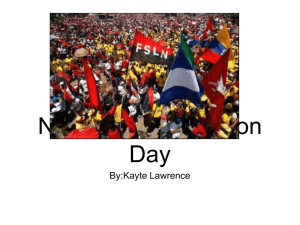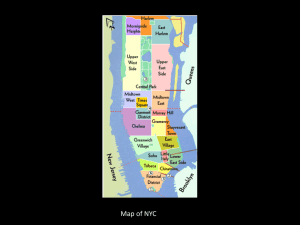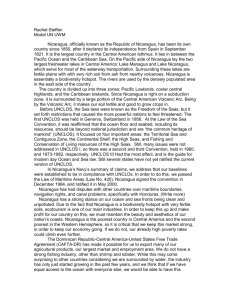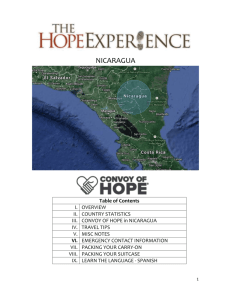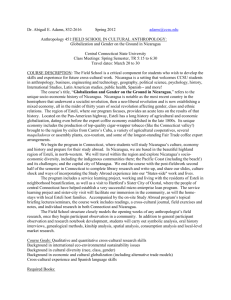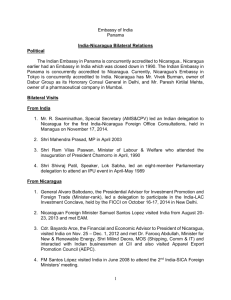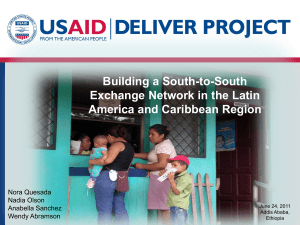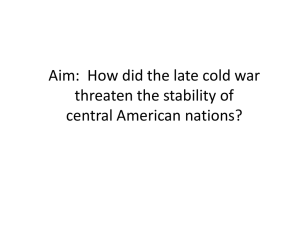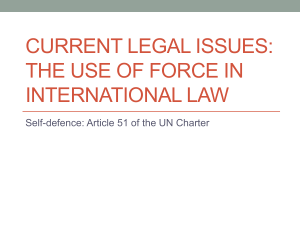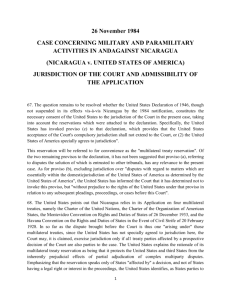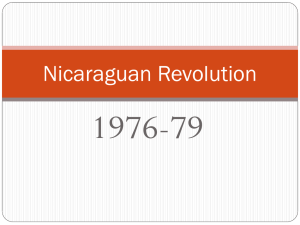Nicaragua
advertisement
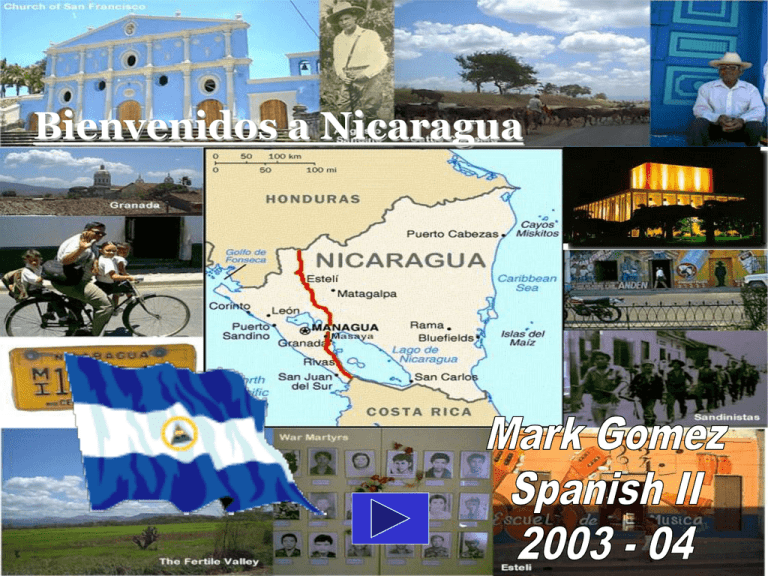
Bienvenidos a Nicaragua Table of Contents HISTORY CULTURE & FAMOUS PEOPLE GEOGRAPHY GASTRONOMY MODERN TIMES ARCHITECTURE & LANDMARKS Pre-Columbian Period Present-day Nicaragua is located south of Mexico and northern Central America. When the Spanish arrived in western Nicaragua in the early 1500s, they found three major tribes, each with a different culture and language: the Niquirano, the Chorotegano, and the Chontal. Each one of these different groups occupied much of Nicaragua's territory, with independent chieftains (called cacicazgos) who ruled according to each group's laws and customs. As the Spanish conquered Central America, they settled along the west and highlands, wiping out the native population almost completely with the spread of new diseases and enslavement. In the east, where the Europeans didn’t settle, most of the indigenous groups survived. The English did, hoevever, introduce guns and ammunition to the Bawihka, who lived in northeast Nicaragua. The People Each one of these diverse groups occupied much of Nicaragua's territory, with independent chieftains who ruled according to each group's laws and customs. – Occupying the territory between Lago de Nicaragua and the Pacific Coast, the Niquirano were governed by chief Nicarao, or Nicaragua, a rich ruler who lived in now the city of Rivas – The Chorotegano lived in the central region of Nicaragua – These two groups had a lot contact with the Spanish conquerors, paving the way for the racial mix of native and European stock now known as mestizos – The Chontal (the term means foreigner) lived in the central mountain region. This group was smaller than the other two, and it is not known when they first settled in Nicaragua Native People Map Chontal Chorotegano Niquirano Colonial Period Timeline Nicaragua's Caribbean coast was first seen by Spanish explorers in 1508. In 1522 a formal military expedition under Gil González Dávila was led into Nicaraguan territory. González then went further into an area governed by the cheif Nicaragua, or Nicarao. Chief Nicaragua welcomed González and gave him large quantities of gold. Thus begins Spanish rule in the new territory of Nicaragua. Throughout the seventeenth century, The local government of Nicaragua neglected agricultural production.Powerful earthquakes in 1648, 1651, and 1663, caused massive destruction in the country. From 1651 to 1689, Nicaragua was attacked viciously from English, French, and Dutch pirates, whom destroyed the city of Granada, Nicaragua’s center of agricultural wealth. The Captaincy General of Guatemala ruled the province at that time, and little was done to solve the problem. 1600’S 1500’S After suffering sickness and dangerous weather, he reached the land ruled by the powerful chief Nicoya.They became friends and soon thereafter, Nicoya and 6,000 of his people were converted to Roman Catholicism. In 1687 the English governor of Jamaica named a miskito who was one of his prisoners "King of the Mosquitia Nation," and declared a region of Nicaragua to be under the protection of the English crown. This event was the beginning of a long rivalry between Spanish and British authorities over control of the Caribbean coast until the end of the nineteenth century. Geography Natural resources of Nicaragua are gold, silver, copper, tungsten, lead, zinc, timber, and fish. Near the city of Rivas is a coastal plain with many volcanoes. Nicaragua is located in the middle of Central America, bordering both the Caribbean Sea and the North Pacific Ocean, right between Costa Rica and Honduras. Climate is tropical in the lowlands near Managua, cooler in the highlands. The Caribbean coast extends with plain areas rising up to the central interior mountains. Gastronomy Click on a dish to see its recipe Maduro en Gloria Indio Viejo Oxtail Stew Tres Leches Indio Viejo Ingredients -2 tablespoons of achiote - 2 1/2 pounds of lean beef - 8 large green bell peppers - 12 garlic cloves - 1/4 cup of vegetable oil - salt to taste - 4 ripe sweet plantains - 12 ounces of cornflour mix - 5 tomatoes - 3 large yellow onions - 1/2 teaspoon of black pepper - 1 cup of orange & lime juice - 1 bunch of mint To Prepare Boil the beef in 3 liters of water in a large cooking pot. Cut one bell pepper and one onion into large slices and place them, along with six garlic cloves, in the pot. After the beef is tender and completely cooked, remove it from the pot, and after letting it cool, shred it into small pieces. Heat the vegetable oil in a large, deep cooking pan. Cut one onion and two peppers into crescent-shaped slices and place them, along with the shredded beef, into the cooking pan. Add salt to taste and stir-fry at medium heat until golden brown. Strain the beef stock and place it in another large cooking pot. Add the achiote and cornflour or tortilla mix to the beef stock, and after placing it under a medium flame, add the yerbabuena. Stir the ingredients into a dough-like consistency. Blend the five remaining bell peppers, the tomatoes, and the rest of the garlic cloves well in a blender. Mix the contents of the blender into the dough and stir well. Add the beef stir fry and the naranja agria juice to the dough and continue blending at low heat. Maduro en Gloria Ingredients 4 tablespoons butter 6 firm bananas, peeled and sliced lengthwise 1 cup heavy cream 1/4 pound cream cheese 4 tablespoons granulated sugar 1 teaspoon cinnamon 1 teaspoon vanilla extract 1/2 cup Curacao liqueur To Prepare Melt the butter in a skillet and brown the bananas very quickly over high heat. Place half the banana slices on the bottom of a buttered pie plate. Blend heavy cream and cream cheese until very soft. Add sugar, cinnamon, vanilla, and liqueur, beating until light and smooth. Spread half of the mixture over the bananas. Place remaining banana slices on top, and spread the rest of the cream-cheese mixture over the dish. Bake in a 375 degrees F. oven for 20 minutes or until almost all the cream is absorbed and the top is lightly browned. Do not allow all the cream to be absorbed, or the bananas will become too dry. Serve hot. If desired, top with whipped cream. Serves 6. Ingredients Oxtail Stew 1/3 cup uncooked white beans 1 tablespoon lard 3 pounds of beef oxtails 3 cloves of garlic, peeled and crushed To Prepare 1 medium yellow onion, peeled and diced 1 medium tomato, diced Soak the beans in cold water overnight OR place beans 2 cups of beef stock in a small saucepan with 1 cup of water and cover. Bring 2 cups of water to a boil and turn of heat. Allow to sit for 1 hour covered 2 tablespoons ground allspice with the heat off. In a heavy skillet brown the oxtails in salt and pepper to taste lard. Place them in a large (about 6 quart) stove top few shots of hot sauce casserole or stock pot. Add all the remaining ingredients except the water and beans. Then, add just enough water to cover the contents of the pot, this should be about 2 cups more or less. Cover and simmer for 1 1⁄2 hours. Drain the beans and add to the stock pot. Continue cooking covered for an additional 1 1⁄2 hours. Stir occasionally and add additional water if necessary, you do not want the pot to dry out. If you like a thick stew, remove the lid during the last half hour of cooking. Ingredients 6 eggs 4 egg yolks 4 egg whites 1/2 cup of milk 2 cups of flour 1 1/2 teaspoons of baking powder Tres Leches 3 1/2 cups of sugar 3 tablespoons of vanilla 2 cans of condensed milk 2 cans of evaporated milk 1 pint of whipped cream 1 1/2 cups of corn syrup 1 sour lemon To Prepare Preheat the oven to 375 degrees. To make the cake part, mix up 6 eggs, 1/2 cup of milk, 2 cups of flour, 1 1/2 teaspoons of baking powder, 2 cups of sugar and 3 tablespoons of vanilla. Make sure that it's all well mixed and then pour it into the cakepan and cook it for 20 minutes. The leches (milks) are supposed to be ready when the cake is done so you need to blend the 4 egg yolks, 1/2 cup of milk, 2 cans of condensed milk, and 2 cans of evaporated milk now. The baño (bath) is applied once the milks have been inserted. Heat up the corn syrup in a bowl while stiring it. Beat the 4 egg whites until they rise and pour in the syrup as you're whipping them. Get a spatula ready for applying the "bath" and start shredding the lemon peals with a cheese grater and add in cherry juice. Beat this mixture until it's well mixed. Once the cake is done, poke holes in it so that they milks can soak into it. Pour in the milks and lift up the sides and do whatever else you have to do to make sure that the cake is completely saturated with milk. Next cover the soaked cake with the "bath" and put it in the oven to cook for another 10 minutes at 400 degrees. Let it cook until the surface is done and then take it out. Architecture & Landmarks Managua Granada Park Granada Cathedral of the Immaculate Conception (the new cathedral) Granada’s Central Square Monument to the Revolution Government House A Government Building Modern Times Nicaragua’s population has grown rapidly in the past half century, as rural residents have migrated to the large cities of Managua & Granada, seeking a better life and safety from violence in the countryside. From a population of 109,352 in 1950, the Capital of Managua reached 662,000 by 1980. By 1993 it had reached 1,600,666 people, more than onethird of Nicaragua’s entire population. The population could exceed 2 million by the start of the 21st century. However, Nicaragua today is still struggling economically. Much of Managua’s downtown still lies in ruin since the earthquakes of 1931 & 1972. Though there are some affluent neighborhoods and middle-class areas. most of the city is occupied by very poor neighborhoods, without adequate water, sewers, and other services. These areas are constantly growing as thousands of poor people pour in from the countryside every year. Some have built makeshift houses of cardboard and tin in vacant lots of the former downtown area. Current Government In order to vote in Nicaragua, you need to be 16 years of age. Nicaragua is a republic. It gained it’s independence from Spanish rule on September 15, 1821. Executive power is held by the president, who is popularly elected for a five-year term. As of January 2002, the president has been Enrique Bolanos Geyer and the Vice President Jose Rizo Castellon. Members of the unicameral legislature and judicial branches are also elected. Nicaragua’s Administrative Government is divided into 15 departments and 2 autonomous regions: Jinotega Leon Atlantico Norte Madriz Atlantico Sur Boaco Carazo Chinandega Chontales Esteli Granada Managua Masaya Matagalpa Nueva Segovia Rio San Juan and Rivas Current Economy lture employs about 45% of the workforce and counts for about one fourth of the gross nat is ranked as one of the poorest countries Nicaragua’s in the world, as about 50% of its population is un The Cordoba, currency and seafood are also exported. The principal manufactured goods are chemicals, textiles, a ulture and Famous People Rubén Darío (1867-1916), Nicaragua The founder of modernism, Rubén Darío is the most beloved poet of Latin American letters. His movement is "the Hispanic form of the universal crisis in literature and spirit that began around 1885". The dissolution of the 19th century, created an intellectual vacuum that manifested itself in art, science, religion and politics, as well as, gradually, in other aspects of life. Modernism in literature represented a deep historical change whose process continues today. Darío wrote Azul (Blue), 1888, Prosas Profanas (Profane Prose), 1896, and Cantos de Vida y Esperanza, 1905, the three works for which he became immortal. Somoza Chamorro Art & Street Graffiti Art has been a treasured institution since revolutionary times. Here are a few examples Nicaragua’s artistic culture. Credits

